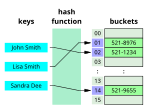Search results
Appearance
There is a page named "Collection (abstract data type)" on Wikipedia
- a collection is an abstract data type that is a grouping of items that can be used in a polymorphic way. Often, the items are of the same data type such...4 KB (441 words) - 11:32, 28 June 2024
- an abstract data type (ADT) is a mathematical model for data types, defined by its behavior (semantics) from the point of view of a user of the data, specifically...32 KB (4,412 words) - 17:38, 26 June 2024
- given that types differ in their methods.: 281 List of data structures Standard Template Library#Containers Collection (abstract data type) Java ConcurrentMap...7 KB (763 words) - 18:46, 13 May 2024
- basis for other abstract data types including the queue, the stack, and their variations. The abstract list type L with elements of some type E (a monomorphic...10 KB (1,409 words) - 12:02, 28 June 2024
- In computer science, a set is an abstract data type that can store unique values, without any particular order. It is a computer implementation of the...25 KB (2,958 words) - 19:07, 13 May 2024
- stack is an abstract data type that serves as a collection of elements with two main operations: Push, which adds an element to the collection, and Pop,...39 KB (4,618 words) - 15:27, 1 July 2024
- linear data structure, or more abstractly a sequential collection. Queues are common in computer programs, where they are implemented as data structures...14 KB (2,077 words) - 19:06, 13 May 2024
- computer science and computer programming, a data type (or simply type) is a collection or grouping of data values, usually specified by a set of possible...27 KB (3,424 words) - 00:43, 3 July 2024
- In computer science, array is a data type that represents a collection of elements (values or variables), each selected by one or more indices (identifying...19 KB (2,587 words) - 15:33, 23 June 2024
- higher-order abstract syntax in a type safe fashion. Here is an embedding of the simply typed lambda calculus with an arbitrary collection of base types, tuples...14 KB (1,322 words) - 05:22, 25 May 2024
- certain abstract data types, specifically sequential collections such as stacks and queues, which returns the value of the top ("front") of the collection without...5 KB (812 words) - 10:25, 15 September 2023
- Scientific collection, any systematic collection of objects for scientific study Collection may also refer to: Collection (abstract data type), the abstract concept...5 KB (469 words) - 18:51, 5 July 2023
- In distributed computing, a conflict-free replicated data type (CRDT) is a data structure that is replicated across multiple computers in a network, with...29 KB (3,351 words) - 23:33, 22 May 2024
- In computer science, a tree is a widely used abstract data type that represents a hierarchical tree structure with a set of connected nodes. Each node...17 KB (2,155 words) - 01:53, 3 July 2024
- Collection (computing) may refer to: Collection (linking), the act of linkage editing in computing Collection (abstract data type), an abstract data type...250 bytes (59 words) - 01:05, 7 March 2020
- structure about data. Data structures serve as the basis for abstract data types (ADT). The ADT defines the logical form of the data type. The data structure...17 KB (1,825 words) - 10:34, 25 June 2024
- (example Tree, Heap) Some properties of abstract data types: "Ordered" means that the elements of the data type have some kind of explicit order to them...9 KB (910 words) - 19:42, 26 June 2024
- Dictionary (data structure))dictionary is an abstract data type that stores a collection of (key, value) pairs, such that each possible key appears at most once in the collection. In mathematical...24 KB (2,769 words) - 18:44, 13 May 2024A data model is an abstract model that organizes elements of data and standardizes how they relate to one another and to the properties of real-world...40 KB (5,059 words) - 23:27, 29 May 2024objects are added or removed. Collections cannot hold primitive data types such as int, long, or double. Instead, Collections can hold wrapper classes such...43 KB (4,279 words) - 10:21, 25 February 2024
- duplicate data collection. Making research data publicly available also has challenges and costs. Some costs are borne by society: For example, data archives
- Barbara Liskov Turing Award lecture (1974-03-28)"Programming with abstract data types". ACM SIGPLAN Notices 9 (4): 50–59. ISSN 0362-1340. DOI:10.1145/942572
- Programming with Windows Forms. Collections Effectively manage (add, remove, find, iterate, etc.) large sets of data. Threading Learn how to run code
)







